In Monday’s article, I posted a picture of one of my favorite Indy cars of all time, the 1992 Lola in the King Motorsports Quaker State livery. That got me thinking about some of my other favorite Indy cars through the long and storied history of the Indianapolis 500. Sometimes a paint scheme can greatly alter the lines and shapes of the cars, and while the car may look great for one driver, it may look ho-hum for another.
But sometimes the cars themselves are just beautiful no matter what paint scheme is on it. Here are some of my very favorites throughout the years.
1939 Boyle Maserati
“Elegant” is the word that comes to my mind upon seeing the 1939 Maserati 8CTF, chassis number 3032. Compared to the brawny cars it ran against in the late 1930s and 1940s, it was graceful. From every angle, the Boyle Maserati just looks right. From the way the hood seamlessly blends into the front grill and the rear of the car perfectly matches the sides, there are no sharp edges to be found on this car.
The car was originally built for grand prix racing in Europe but never fared well. Upon seeing a similar car running in the Vanderbilt Cup in 1937, Wilbur Shaw reportedly guaranteed Mike Boyle a victory in the Indianapolis 500 if he could get his hands on one.
Unfortunately, Boyle’s initial order with the Italian company produced an incorrect version of the Maserati for 1938, a smaller, underpowered effort that didn’t make it onto the IMS track. However, the correct version arrived in time for the 1939 running. Under the watchful eye of master mechanic Cotton Henning, the Maserati Boyle Special became the most successful car to ever run in the Indianapolis 500.
Though the 350 horsepower engine was out-muscled by the Millers, the Sparks, and the Winfields (the precursor to the legendary Novi engines), the Maserati engine’s wider power band made the car much more drivable across a wide range of engine speeds. Wilbur Shaw had a relatively easy day and won the 1939 500 by nearly two minutes. It was the first win for a foreign car in the race since Dario Resta won the 1916 “500” in a Peugeot.
Shaw returned with the same car in 1940 and again ended up in Victory Lane, becoming the second three-time winner and the first driver to win the Indianapolis 500 in consecutive years. Shaw was well on his way to becoming the first driver to win three Indianapolis 500s in a row in 1941 when a wheel collapsed on Lap 152. Following World War II, the chassis was repainted white and continued its service as the Bennett Brothers Special, carrying Ted Horn to third-place finishes in 1947 and 1948.
By 1949, the car was finally starting to show its age when Lee Wallard drove it to a 23rd place finish. However, a year later the car was pressed into service one final time when an impressive looking rookie with a funny name needed a mount for his rookie test. He didn’t qualify that year, but it seems appropriate such a beautiful car would end its career in the process of kick starting the career of Bill Vukovich.
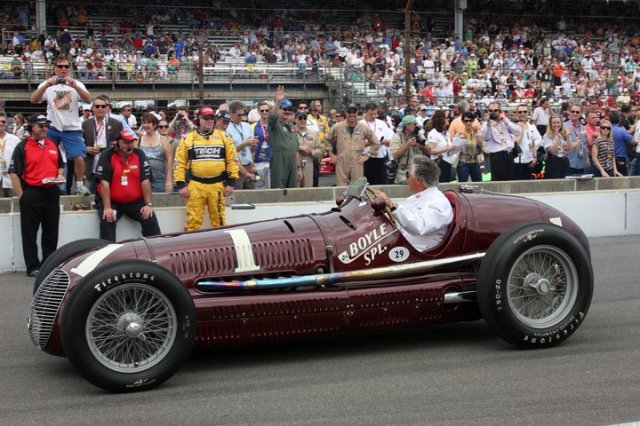
1965 Lotus 34
I’m going to plead ignorance up front here. Picking out the different Lotus cars of the mid 1960s is, for me, about like picking out different shades of blue from the hundreds of options when buying paint at Lowe’s. I know they’re all very slightly different, but unless I’m staring at them right next to each other and someone is pointing out the differences to me, they all kind of look the same to me. That said, they are all beautiful.
However, the Lotus that particularly sticks out in my mind is the Lotus 34 that AJ Foyt on pole in 1965. The Lotus 34 was a slightly older model than the Lotus 38 that Jim Clark would drive to victory that year after starting alongside Foyt in second. Foyt’s Chassis #2 was also driven by the likes of Dan Gurney, Parnelli Jones, and Clark himself at various times.
I am particularly fond of the paint scheme on AJ’s 1965 pole winning car. The white, blue, and red Sheraton-Thompson livery was nearly identical to his 1964 winning paint scheme that adorned his front-engined Watson roadster. While others have tried to duplicate paint schemes from front-engine to rear-engine cars, they have mostly failed. This effort succeeded masterfully, though.
I’ve always thought all the Lotus cars looked particularly “delicate,” but that may well have been because they were often seen against the much bulkier roadsters of the early ’60s. There is no doubt that the Lotus cars accelerated the rear-engine revolution, and while it was likely the “funny little cars” were to eventually push out the front-engine racers of the time, Lotus’s expertise and technical superiority sped the process along.
In a sad ending to their Indianapolis story, their revolutionary, all-wheel drive Type 64 racer was supposed to be head-and-shoulders above the competition, and for the early practices sessions of 1969, it was. Three cars were entered – two factory cars for Graham Hill and Jochen Rindt and an STP Special entered by Andy Granatelli for Mario Andretti. Mario was far and away the fastest driver in practice until a wheel hub failed and caused a massive crash. Mario’s Lotus 64 was destroyed, and he suffered relatively minor burns to his face. In the ensuing days, Colin Chapman withdrew the remaining Team Lotus cars when they were determined to be unsafe for competition (though in reality neither Hill or Rindt were able to come anywhere close to matching the speed of Andretti). Neither Team Lotus nor Colin Chapman would ever return to Indianapolis.

The fact that Lotus only won one Indianapolis 500 is nearly as amazing as the fact that Lola only won three. Given the legendary names that drove Lotus cars during their IMS tenure of 1963-1969 – names that included Foyt, Andretti, Clark, Gurney, Hill, and others – Jim Clark’s victory would be the only time the British manufacturer would find victory lane.
1959-1963 Watson Roadster
Much like my ignorance of the finer details of the various Lotus entries over the years, I’m not totally up to snuff on the evolution of the Watson Roaster. Folks more in tune with that era would be able to point out the differences in hood scoops, oil reservoirs, and push bars. Quite honestly, to me a Watson Roadster is a Watson Roadster. They are all beautiful to me.
And perhaps for the sake of just beautiful cars, narrowing it down specifically to Watson roadsters might be a bit restrictive. In the truest sense of the term, this would refer to a roadster specifically built by AJ Watson himself. However, there were a huge number of racers that were copies of the original Watson roadsters but built by other craftsman, often nearly identical copies of those built by Watson. One of the best examples is the 1961 winning car of AJ Foyt that looks nearly identical to a genuine Watson but was actually built by Floyd Trevis.
When I think of actual Watson roadsters, though, there are two winning cars that immediately come to my mind. The first is Jim Rathmann’s 1960 winning Ken-Paul Special. Known as the Greatest Two-Man Battle in the history of the Indianapolis 500, Rathmann and Rodger Ward battled nose-to-tail throughout the second half of the race with Rathmann gaining the victory when Ward had to back off the gas with only three laps remaining due to excessive tire wear. It was a particularly sweet moment for Rathmann who had been runner-up the previous year to Ward.
The Ken-Paul Special was a brand new car in 1960. In fact, Rathmann and chief mechanic Chickie Hiroshima personally drove to AJ Watson’s shop in Glendale, CA, to receive the car and tow it back to Indianapolis in the spring before the gates opened at IMS. (If you ever really want to ruffle Donald Davidson’s feathers, ask him sometime who was the real chief mechanic on the 1960 winning car. It might be the closest you’ll ever come to hearing a curse word on-air from the great historian’s mouth.) The simple, beautiful blue livery wasn’t adorned with flashy emblems or sponsors. A simple “Ken-Paul SPL,” a red 4 on a circular white background, and a red pegasus (which might have been a Mobil Oil sponsorship) were the main logos on the car.
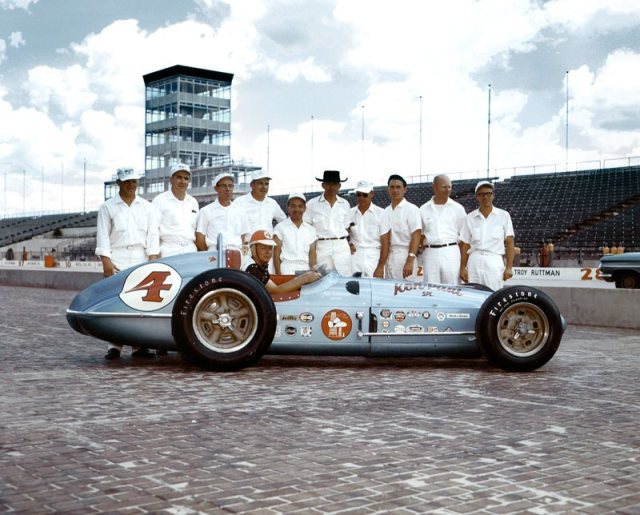
Perhaps more famous than the Ken-Paul Special is a car that many would say is in the top 5 most famous cars ever to race at Indianapolis. The Agajanian-Willard Battery Special, known more famously to the masses as “Ol’ Calhoun” (though there is some debate as to whether “Ol'” is really part of the name) debuted at the Indianapolis Motor Speedway in 1960 in the hands of rookie Lloyd Ruby. But the car met its perfect match in 1961 when Parnelli Jones took over the seat.
The livery was a bit more bland in 1961 than it’s more famous variations in 1962 and 1963, but it was the same car. In 1962, Parnelli put his name forever in the history books when he became the first driver to turn a lap at the Speedway in under one minute, breaking the 150 mph barrier. A year later, Parnelli put his name again into racing lore when he won his first and only Indianapolis 500.

1990-1992 Lola
I firmly believe any race fan will say the epitome of a “real Indy car” is whatever was en vogue when their fandom started in earnest. For me, it was the late 1980s and early 1990s. When the Bruce Ashmore-designed Lola debuted in 1990, it was a stunningly beautiful race car!
Through the mid 1980s, Lola had been an alternative to the March chassis but saw limited success, especially at Indianapolis. The most prominent team using the Lola chassis during that time was Newman Haas Racing whose co-owner, Carl Haas, was the North American importer for the British-made Lola Cars.
No matter how beautiful the paint scheme was, it was a matter of putting lipstick on a pig. While the dominant March chassis had a narrow, pointy nose (at least after the bulbous 1985 iteration), the late 1980s Lolas had a wide, flat nose and looked overweight. The cars were somewhat fast, though usually only when mated with the powerful Chevrolet engine. Mario Andretti dominated the 1987 500 before engine troubles forced him to the sideline. His son, Michael, was competitive as well in 1989 before his Chevrolet engine expired and ended his day. Most notably, however, was the run of Al Unser, Jr. in 1989, who came within six turns of capturing victory for Lola.
In terms of looks, however, the Lola didn’t hold a candle to the Penske cars of the area or the older March chassis that was still hanging on. That changed, however, for 1990.
Bruce Ashmore came to Lola in the late 1980s and started working on the T8800. For 1990, the T9000 was a clean-sheet design and it looked the part. It had beautiful, slender lines, and most liveries looked excellent on it. I was personally a fan of the two Galles-Kraco cars of Al Unser, Jr. and Bobby Rahal. The pin stipe along the nose that then went over the roll hop added to the pointy look of the car.

Minute adjustments to the rear wings along with a small number of other cosmetic changes only helped the car’s look in 1991. More major changes to the rear of the car came in 1992 when Lola began creating customized engine cowls for the much smaller Buick V-6 engines and the brand new Ford-Cosworth XB engine. The lower cowl helped the already beautiful car flow even better. Of the versions produced for Chevrolet, Buick, and Ford-Cosworth engines, my favorite looking variant was the Buick. Both the Kenny Bernstein cars of Roberto Guerrero and Jim Crawford along with the John Menard cars of Al Unser, Sr. and Gary Bettenhausen were stunning entries. (Menard’s third entry in the race, Tom Sneva, drove a standard issue 1991 Lola.)
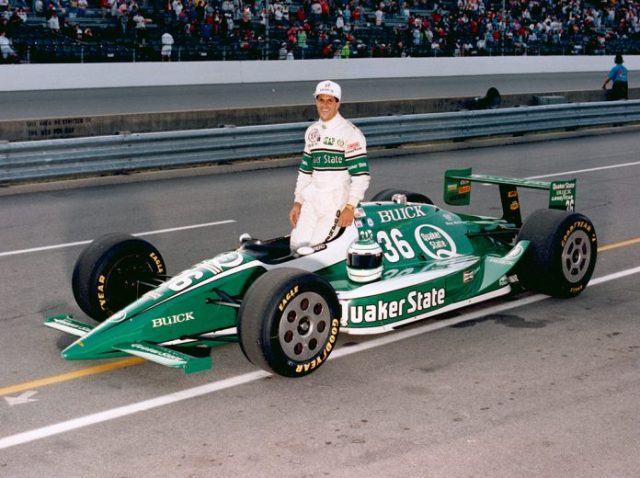
Unfortunately, many drivers suffered debilitating foot, ankle, and leg injuries during the Month of May 1992. For 1993, regulations required fairly significant changes to the front of the car. Additionally, rear wing changes in 1993 and 1994 threw the aesthetic balance off in my eye. I wasn’t nearly as much a fan of those cars as I was the 1992 car.
At the same time as those regulations were coming into place, Ashmore left Lola and started the design for Reynard’s debut in IndyCar competition in 1994. I personally thought the early Reynards, particularly in oval configuration were dog ugly, but they were fast. By the end of the 1990s, the Reynards in road course trim were really beautiful cars, but since that’s beyond the scope of this article, I’ll leave it at that.
For all the success Lola had in CART through the late 1980s and 1990s, they only won a single Indianapolis 500 in that period to go with their 1966 win with Graham Hill and 1978 triumph with Al Unser. They would win season championships in each year from 1990-1993 and other drivers would come close to Indianapolis glory (notably Scott Goodyear and Davy Jones), but Arie Luyendyk’s 1990 Indianapolis 500 win would be Lola’s only victory of the era.
1991 Penske PC-20
I love the 1991 Lola, but the car that bested Michael Andretti’s T9100 at the Indianapolis 500 that year also bests it in my mind’s eye. As far as I’m concerned, the 1991 Penske PC-20 is the most beautiful Indy car ever created. Period.
I know that’s a bold statement and people who became fans during a different era will disagree with me. Some will say Bill Vukovich’s cigar-shaped Fuel Injection Special of 1953 was what an Indy car should look like. Or maybe the aforementioned Watsons or Lotuses. I know Johnny Rutherford’s 1980 Chaparral, the “Yellow Submarine,” would also garner some votes. But to me, the Marlboro car that Rick Mears drove to victory in 1991 takes the cake.
The PC-20 was an evolutionary derivative of the 1988 PC-17 that swept the front row. Penske Cars had built a number of cars during the late 1970s and through the 1980s. Some, like the 1979 PC-6, 1981 PC-9, and 1982 PC-10 were successful. Others like the 1986 PC-15 were just dogs.
Designed from the ground up by Nigel Bennett, the PC-17 debuted in 1988 and dominated the Month of May. For the first time in history, a single team swept the front row when Rick Mears, Danny Sullivan, an Al Unser put three Penske-owned cars in the first three positions. Those drivers would lead 192 of the 200 laps with Rick winning his third 500.
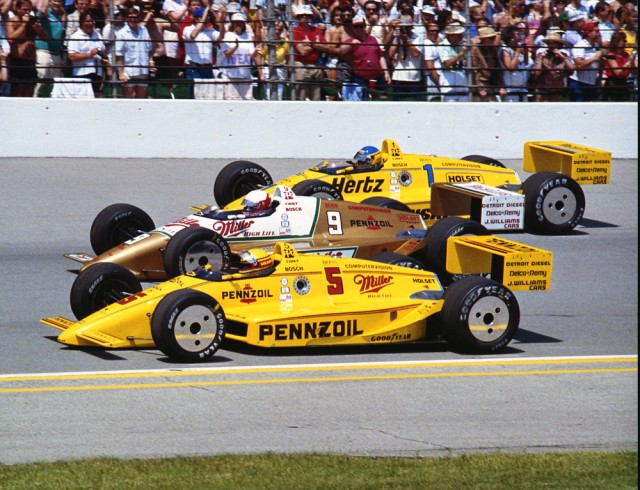
The PC-17 was followed by 1989’s PC-18. The car again swept the front row though this time, the outside position was held by Patrick Racing’s Emerson Fittipaldi. (How Patrick Racing attained a brand new PC-18 is a long and complicated story of swapping drivers and sponsorships that is best suited for another article.) Mears won his record-setting fifth pole position, but it was Fittipaldi who took the PC-18 to victory for Penske’s rival team.
The PC-19 again showed dominance at Indianapolis with Fittipaldi, now with Team Penske, winning the pole at record speeds and leading most of the first half of the race. Unfortunately, blistering tires in the second half of the race kept Emmo out of Victory Lane for a second consecutive year.
For 1991, Penske returned to the Speedway with the follow-up to the PC-19, the 1991 PC-20. Mears once again won the pole position (and in the process spoiled a storybook tale of AJ Foyt’s comeback). It was the first time in my years at the Speedway that Mears was not in the Pennzoil car, that sponsorship having moved from Penske to Jim Hall’s reincarnated team with John Andretti. Mears would now be in the #3 Marlboro car, an exact sister car to Emerson Fittipaldi’s #5.
The PC-20 didn’t dominate the race in the way the previous three versions of the PC family did. Though Mears started on pole, he struggled with his car early on, nearly falling a lap behind Michael Andretti within the first 50 laps. Fittipaldi took a while to move forward from his fifth-row starting position, but eventually Emerson looked like he might have the race in hand as the race passed the 400-mile mark.
Unfortunately, it wasn’t to be for Emmo as a clutch failure led to a difficult pit stop and Emerson destroying his gearbox trying to exit it pits.
When Danny Sullivan had his Alfo Romeo engine detonate in one of the largest plumes of blue smoke I’ve ever seen at a race track, Michael Andretti pitted for late fuel and set up the great finishing battle with Mears. While people often talk about the “shootout” to the end of the race, including Mears himself, it was really only about one lap of excitement. Michael passed Rick. Rick passed Michael one lap later. And the race was pretty much over. Rick drove away to a fairly easy win after that once he had gotten his car working perfectly and Michael struggled with a very pushy car over the final 14 laps.
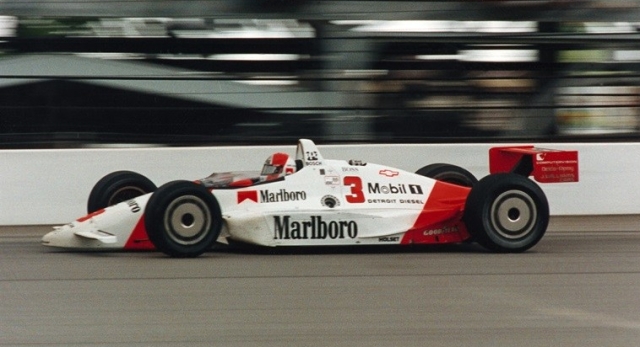
Unfortunately, the exact car that Rick won the 1991 Indianapolis 500 with was the same car he has his massive crash with in 1992. Roger Penske rebuilt the car to show condition, and it was on display at the Indianapolis Motor Speedway Museum in 2011.
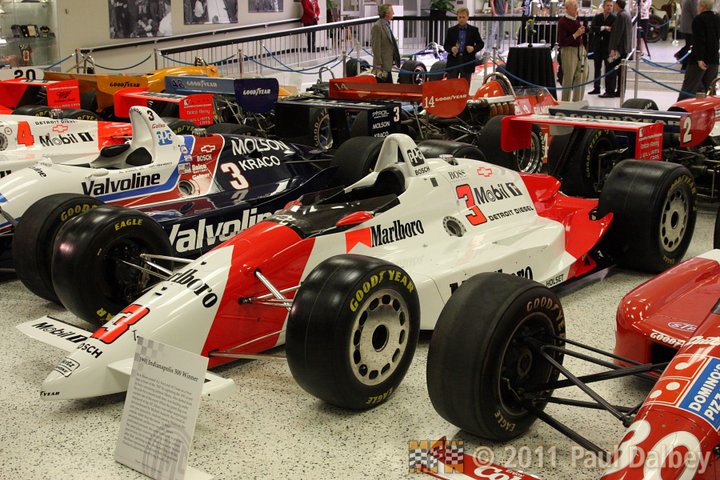
I am not much of a collector of 1/18 scale models, but I sprung for one of Carousel 1’s models of Johnny Rutherford’s 1975 Gatorade McLaren, one of the most perfect combinations of car and paint scheme in Speedway history in my eyes. There were some other rather good-looking McClarens too, particularly David Hobbs’ 1974 Carling Black Label entry.
I am sad that the 2000 Swift never took to the Speedway, because that dart-shaped beauty is the prettiest thing with 4 wheels I have ever seen. Yeah, it was slow… but man it looked fast. Swift’s 008 and 014 Atlantic Series cars were real lookers too.
LikeLike
I’m not much of a 1/18 scale model collector, but I had to spring for Carousel 1’s model of Johnny Rutherford’s 1975 Gatorade McLaren. That is probably my favorite combination of car and paint scheme in Speedway history.
Sad that that gorgeous (if slow) 2000 Swift never took to the Speedway and can’t count. That dart-shaped beauty is the prettiest thing with 4 wheels I have ever seen.
LikeLike
Not that I want to drag anything from the split into this, but I think any of those late 1990s Champ cars would have been amazing to see at the Speedway. Can you imagine Gil de Ferran driving his 2000 Reynard/Honda at IMS? I don’t think it’s inconceivable he could have gone 240-245 mph. That would have been a site (and sound) to behold!
LikeLike
From childhood, I was a road racing fan, but I would read library books, etc., interested in the biggest race in the world (I have no problem at all referring to the 500 as the Greatest Spectacle in Racing). So it’s not much of a surprise that I liked the Boyle Special Maserati, even in old black-and-white photos — but in auto racing, more than in most things, color photos or seeing the cars in person takes the appeal to a far higher level … and the clean simplicity of that Maserati is timeless.
I was always fascinated by photos of the 1948 Blue Crown Special. One of the first car model kits I ever assembled (pretty badly, no doubt) was Foyt’s 1964 winning roadster — even as a fan of the rear-engined cars, assembling that model helped me “get” roadsters. Clark’s 1965 Lotus was a classic to me, as were the minimalist 1968 Lotus turbines. The early Eagles were elegant yet racy looking. I liked the Interscope Parnellis.
These days, we have only different liveries to differentiate the cars — and I’ve often wondered why, with all the graphics ability we have — cars (and drivers’ helmets) have what I consider to be overdone (even “jumbled”) graphics treatments. (I guess I just answered my own question — graphics are so complex mainly because they *can* be.)
LikeLike